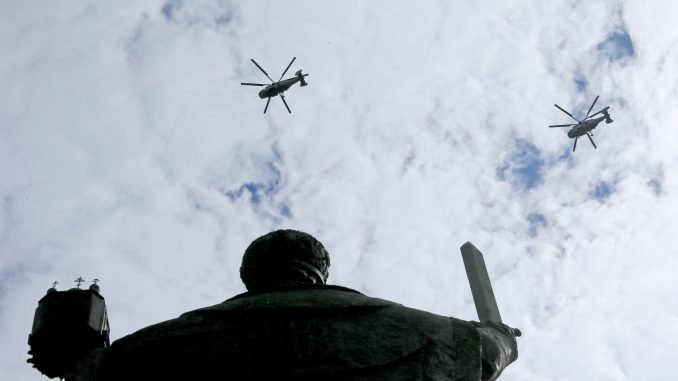
The picture painted by the media also gave the impression that the Iskanders were to be based in Kaliningrad oblast on a permanent basis. Domestically, Russian commentators repeatedly suggested that permanently basing the Iskanders in Kaliningrad would be an adequate response to the North Atlantic Treaty Organization’s (NATO) activities in Central Eastern Europe. Such arguments are certainly not new: already in 2008, the Russian military hatched plans to deploy Iskanders to Kaliningrad, and then–Russian president Dmitry Medvedev in fact mentioned this possibility publicly (RIA Novosti, June 5, 2008; Gazeta.ru, October 10, 2016), Jörgen Elfving writes the Jamestown Foundation.
Iskander ballistic missiles have been moved in and out of Kaliningrad oblast on several occasions in the past—for example, during an exercise on March 16–21, 2015 (Mil.ru, March 18, 2015). In this most recent case, the Russian Ministry of Defence also declared that the movement of the missiles was part of an ordinary military exercise. And there is nothing to suggest that the 152nd Missile Brigade in Chernyakhovsk (Kaliningrad oblast) has been equipped with Iskanders so far (RIA Novosti, October 8). Rearming Russian missile brigades is usually done at Kapustin Yar (Astrakhan oblast, just east of Volgograd), where the Iskander missile system is handed over to units who are trained on the new equipment, do some live firing and then return to their ordinary garrisons (Vegchel.ru, June 6). Nonetheless, the presence of necessary infrastructure at a missile brigade base is a precondition for rearming. So the erection of tent-style storage sites in Chernyakhovsk might indicate that the 152nd Missile Brigade in Kaliningrad could indeed soon be armed with Iskander missiles (Mil.ru, October 21).
Nine missile brigades across Russia are currently equipped with Iskanders, and according to a source in the Missile Troops and Artillery Staff, two further brigades remain to be armed with this advanced missile system (Gazeta.ru, October 10). The Russian ground forces are presently divided into 11 armies; and assuming that each of these armies features an attached missile brigade, this strongly suggests that all of Russia’s army-sized ground forces units are specifically planned to include Iskanders in their tables of organization and equipment. However, the specific announcement that two brigades are currently awaiting deployments of Iskanders implies that either one of Russia’s 11 armies or the Kaliningrad-based 152nd Missile Brigade (attached to the Naval Infantry and Coastal Defence, not the ground forces) will presumably not be equipped with this theatre ballistic missile. In the latter case, Russia would have to redeploy other missile brigades to Kaliningrad oblast if it wants a missile with a longer range in that area than the OTR-21 Tochka (NATO reporting name: SS-21 “Scarab”) presently deployed there. Such a scheme would back up the Russian defence ministry statement claiming that the October deployment of Iskanders to Kaliningrad was part of an exercise activity—especially if it can be ascertained that these missiles were indeed later transported back to Russia proper.
However, it is not just Iskanders that are of interest in the Baltic Sea region. Two Buyan-class corvettes, the Zelenyy Dol and Serpukhov, were also recently redeployed from the Black Sea Fleet to the Baltic. Both ships will be part of a newly formed division there, which will receive another three corvettes of the same class before 2020. The Baltic Fleet is also said to have received the Bal coastal defence missile system. And the advanced Bastion coastal defence system is also routinely mentioned in this context. The Bal will replace the older Redut missile, presently wielded by the 25thCoastal Missile Regiment at Donskoye. This regiment is reportedly being upgraded to brigade strength (Izvestia, October 26).
Recent military developments in the Baltic Sea region, including the formation of the 11th Army corps in northwestern Russia earlier this year, cannot be considered in isolation. Together, they add to Russia’s anti-access and area denial (A2/AD) capabilities in the area. In January 2015, Kaliningrad oblast was specifically singled out—in addition to the Arctic and Crimea—as a high-priority area for continued investment in force generation and the development of Russian military capabilities (Vz.ru, January 30, 2015). But until recently, Russia’s Baltic exclave saw little such progress, especially compared to what has been going on in the Artic and Crimea (see EDM, December 9, 2014; March 27, 2015; September 21, 2015; November 6, 2015). Such halting progress may have contributed to the dismissal of the former commander of the Baltic Fleet, Vice Admiral Viktor Kravtjuk, and a number of other high-level officers this past June (see EDM, July 6, 19). The mass sacking presumably removed an administrative obstacle to moving from words to deeds when it comes to boosting Russia’s military capabilities in Kaliningrad oblast. Another explanations may be that the leadership in Moscow recently concluded it needs to more substantially counter NATO in the region. Or perhaps Russia is militarizing Kaliningrad in anticipation of Sweden and Finland joining the North Atlantic Alliance. Moscow has frequently stated that should Sweden decide to join NATO, Russia would take military measures.
Although Kaliningrad oblast is too small to host an overwhelming military buildup, this Russian region has apparently begun to enjoy renewed attention from Moscow. It cannot be excluded that this attention will in practice result in ever more robust Russian A2/AD capabilities in the Baltic region—with serious implications for neighbouring countries and the NATO alliance.

Be the first to comment